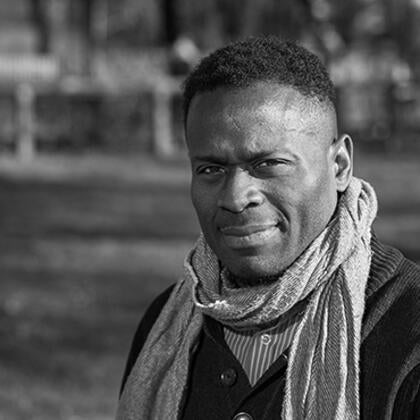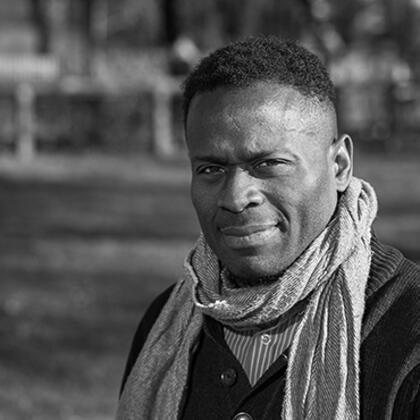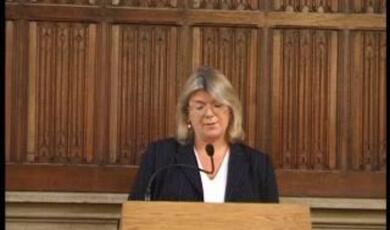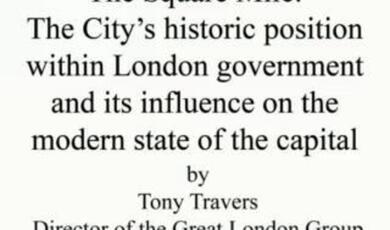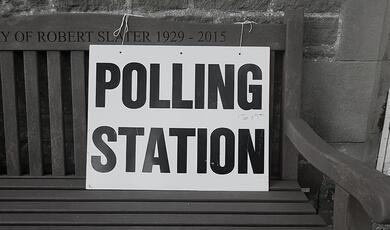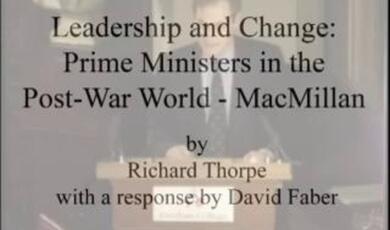Blacks Britannica: Diversity in Medieval and Early Modern England
Share
- Details
- Transcript
- Audio
- Downloads
- Extra Reading
Africans have been present in England for more than two thousand years, but we rarely see them or hear about them. And often their existence is dismissed as a figment of 'political correctness' or 'wokism.' This lecture will critically assess the myth of England's story as a 'sacred white space' and examine the evidence for diversity in medieval and early modern history. Africans are integral to English history and forgetting this diminishes Englishness, by preventing us from understanding ourselves.
Download Transcript
When you reach England if you come to London pass through it quickly, for … all kinds of men crowd together there from every country under the heavens …
Richard Devizes, Chronicles Concerning Richard the First King of England (1192-1198).
Africans in Medieval England
Our imagination of England, — is more potent than our understanding of English history. When we think of the Medieval period (1066-1485) it is too often an escapist fantasy of chivalry and pageantry gorged with the ‘glory’ of wars against France. This tapestry does contain ethnic groups: Normans, Anglo Saxons, Norse warriors. But the assumption remains despite the obvious ethnic dynasties and inter-ethnic conflicts, that medieval England was mono-ethnically white. The ‘Matter of Britain’ underpins the nation’s identity of itself and creates a space for witches, dragons and trolls but not for Africans! But Africans did live in Medieval England and were described by various terms such as: ‘Black’, ‘Ethiopian’ (used generically to refer to all Africans), ‘Moor’, ‘Blackamoore’ and ‘Garamantes.’ Other terms such as ‘Saracen’ were generic enough to describe Africans, as well as people from Asia Minor and elsewhere. Sometimes the terms ‘Black’ etc. were used singularly or in conjunction with each other. For example, Bartholomew was an African on the run in Nottingham (England) in the thirteenth century. He is mentioned in the Pipe Roll of 1259, where he was called an ‘Ethiopian’ and a ‘Saracen.’ The Pipe Roll says, Bartholomew was not born in England but that ‘Roger [de Lyntin] brought him to England’ although, the record does not say where he came from. The roll also provides ‘a mandate [dated 21 June 1259] to arrest’ Bartholomew, for ‘running away from his said lord [Roger de Lyntin].’ Bartholomew may have been on his way to the city of Nottingham to escape his lord’s authority.
We now know some English medieval cities had diverse populations. The medieval English writer Richard Devizes (above) satirically describes London as being populated by ‘Moors,’ ‘magicians’ and ‘men from all nations’ that ‘fill all the houses. He specifically names Garamantes (Moorish Africans) as one of those many nations.
This England also included people such as the ‘Ipswich man.’ He was buried in the cemetery of Grey Friars monastery (Ipswich) between the dates of 1225-1285. He was the subject of a BBC documentary called History Cold Case. We do not know where in Africa he originated from. It is possible that his presence in the monastery is linked to the medieval church’s international connections or the Crusades. During the Ninth Crusade ‘four Saracens’ were brought to England by the crusading English knight Thomas de Clara in 1272. This knight was associated with Robert Tiptoft the benefactor of the Grey Friars monastery. There are many other Africans (unnamed) portrayed in medieval English art, and literature such as the African man in the Abbreviatio Doomsday Book. The Doomsday Book was written in England in 1241. The African appears in the section concerning the county of Derbyshire, and he is dressed it appears as a Medieval artisan or tradesman and is dangling or looking upwards at the letter ‘I.’
Africans in Early Modern England (1485-1660s)
These were Africans and people of direct African descent that lived in early modern (Tudor and Stuart) England. In particular their presence was significant in cities such as: London, Northampton, Plymouth and Bristol. Africans also lived in rural villages and hamlets such as Holt in Worcestershire, and Hatherleigh in Devon. Some of these people of African descent were born in England others had origins from the Iberian Peninsula from the countries now called Spain and Portugal. There were Africans that came from particular kingdoms in West and North Africa; and also, people of African descent who came to England through or via the Caribbean and Central America. These last sets of peoples arrived as a result of connections with English merchant adventurers, explorers and travellers.
It is not possible to know the exact number of Africans living in England at this time. But their numbers were certainly more than ‘a few strolling players.’ For example, in the parish of St Botoloph without Aldgate (London), Africans constituted 5% of the total population.[1] This was a cosmopolitan parish as John Stow and Ranulphus Hidgen tell us. This parish included: Native-Americans, Huguenots and émigrés from Iberia, Portugal and Italy, as well as French and Sephardi Jewish tradesmen and craftsmen.[2] Interestingly, many of the parishes close to St Botolph that include Bishopsgate, East Smithfield, Shoreditch and Stepney also had diverse populations living there too. Other parishes with a significant African population included those of St Olave and Hart Street (London) and St Andrews in Plymouth where the population were each 4%. The African population in these parishes would have been visible and significant.[3]
In early modern England there were significant individuals such as John Blanke ‘the black trumpeter.’ He was a musician depicted twice on the Westminster Tournament Roll of 1511 that celebrated the birth of the son of Henry VIII and Katherine of Aragon. Blanke has been the subject of exhibitions and now a BBC plaque. A less famous, but arguably more significant person, was the unnamed African craftsmen living in Cheapside, London between the years 1553-1558. He was referred to by William Harrison in 1577 as the ‘Negro that would never teach his art to any.’ This man of African descent came from the Iberian Peninsula with an art for making ‘fine Spanish needles.’ But ‘would never teach his art,’ and to quote the historian Thomas Fuller the art ‘dyed with him,’
… the first Spanish needles in England were made, in the Reign of Queen Mary, in Cheapside, by a Negro but such his envy, that he would teach his art to noone, so that it dyed with him. More charitable was Elias Crowse …
This African craftsman appears to have left his mark on early modern society and chroniclers noted his presence until the beginning of the nineteenth century where he disappears from the history books.
Other people of African descent include the woman Mary Fillis of Morisco. This young woman was about twenty years old when she was baptised in St Botolph without Aldgate, London on 3 April 1596. She was described in contemporary parish registers, churchwarden’s accounts and the Memorandum Daybooks. In those records her ethnicity is described as being ‘Black,’ ‘a Moor,’ ‘a Blackamoore’ and ‘of Morisco’. And it is possible that Fillis and Mary were cognoscente of their past, offering the term ‘of Morisco’ to define their own identity. Fillis of Morisco had the profession of a basket and shovel maker which may mean that he was also a metal worker. Moorish metalworkers were famous throughout early modern Europe.
Another woman of African descent living in early modern England was Grace of Hatherleigh. Hatherleigh is a village in Devon. Her records start from just outside the Tudor period and continue until 1613:
13/05/1604, ‘Grace a Negyer,’ baptised 13 May 1604.
10/08/1606, ‘Rebecca, a base daughter of Grace, a negyer [negro]’ baptised 10 August 1606.
23/12/1607, ‘Rebecca a blackmore base daughter of Grace,’ burial 23 December 1607.
08/05/1611, ‘Honour a Negro’ ‘… a base daughter of Grace,’ baptised 8 May 1611.
06/06/13, ‘Honour’ described as an ‘illegitimate’ child of Grace, burial 6 June 1613.
These records provide snapshots in the life of a family of African descent living in Hatherleigh. This is a family whose female head Grace was referred to in every entry but one by terms such as ‘Negro’ or ‘Negyer.’ This woman appears to have been baptised as an adult in 1604, because she conceived two years later. As a recipient of an adult baptism, it is likely that she had come from another country, because children born in England were usually baptised just after birth as Grace’s children were. Furthermore, in this case Grace’s baptism of her two ‘illegitimate’ or ‘base’ children occurs without any reference to who the father is, or whether Rebecca has the same absentee father as Honour. Both of Grace’s children died early, Rebecca just after a year and four months, Honour after two years and one month. Grace herself disappears from the records after the last entry in 1613.
Other people of African descent living in Tudor England include Henrie Anthonie Jetto. Jetto came to England as an adult and was baptised at the age of 26 in 1596 in Holt, Worcestershire. He was described as ‘a Black’ a ‘Black More,’ ‘a Black-moor,’ and as being ‘Jetto’ from the French word for ‘Black.’ This last word appears on his records as an ethnic sobriquet in the same way as the other ones. He lived in Holt in Worcestershire on the estates of Henry Bromley where at first, he seems to have had a lowly status. The term the recorder used to describe his position was ‘belonging to Henry Bromley.’ This status changes, and he is eventually referred to by his profession as ‘the gardener’ of Henry Bromley. By the time of Bromley’s will written on 20 September 1626, Jetto had become an independent man with property, and he is referred to and described himself as ‘Jetto of Holt.’ Jetto married a woman whose ethnicity is undetermined who was called Presida. He had seven children with her and another child from a woman unknown, but this child’s name was and is listed in Jetto’s will. These children had over thirty-two grandchildren, most of whom lived in the Holt area. This would have made the Jetto family a very significant population in what was then a relatively small village.
There were also African merchants, mapmakers, explorers, and noblemen and women. The latter as dignitaries included people such as Dederi Joaquah from the country of Cestos in West Africa. Joaquah was baptised in St Mildred’s Poultry, London on 1 January 1611. Joaquah came to England as a result of diplomatic overtures from West African kings that sought to develop relations with western European countries outside of Spain and Portugal.
© Dr Nubia, 2021
References and Further Reading
Adams, Susan, et al. ‘The Genetic Legacy of Religious Diversity and Intolerance … Christians, Jews, and Muslims in the Iberian Peninsula.’ The American Journal of Human Genetics, 83: 6 (2008), pp. 725–736
Adi, Hakim (ed.). .Black British History: New Perspectives from Roman Times to the Present Day (London: Zed Books, 2019)
Author unknown. The Calendar of the Patent Rolls, Henry III, 1258- 1266 (London, HMSO,1910), p.28.
Author unknown. Doomsday Abbreviatio [Abridgement], Exchequer: Treasury of the Receipt, Miscellaneous Books, p. 196, National Archives, Kew, London, E36/284.
Benton, Lauren. Law and Colonial Cultures: Legal Regimes in World History, 1400-1900 (Cambridge: Cambridge University Press, 2002)
Chandler, Wayne, in Ivan Van Sertima (e.d.). The African Presence in Early Europe (New Brunswick, Transaction publishers, 1985),
Davies, Robert Rees. The First English Empire: Power and Identities in the British Isles 1093-1343 (Oxford: Oxford University Press, 2000)
Habib, Imtiaz. Black Lives in the English Archives, 1500–1677: Imprints of the Invisible (London: Ashgate, 2008)
Miranda Kaufmann, Black Tudors: The Untold Story (London: One World, 2019)
Onyeka Nubia, Blackamoores: Africans in Tudor England, Their Presence, Status and Origins (2013, new edition, London, Narrative Eye: 2014)
-----. England’s Other Countrymen: Black Tudor Society (London: ZED Books, 2019)
Weever, John. Ancient Funeral Monuments of Great Britain and Ireland and the Islands (London: J. Wilkie, 1767).
[1] Onyeka, Blackamoores, pp. 249-264.
[2] Onyeka, Blackamoores, pp. xxii, xx, xxvi-xxvii.8, 15, 59, 65, 131-132. 134, 154, 211, 219, 221, 231.
[3] Onyeka, Blackamoores, East Smithfield, pp. 72, 109, 133, 154, 219, St Olave Hart Street, pp. 8. 44. 51, 65, 127, 211, Stepney, pp. 62, 128, 231, Other parts of London, pp. 47-48, 114-115, 132-135, 178-179; Plymouth St Andrews, xxii, xiv, xxii, xxvi, 8, 15, 17, 18, 27, 28, 42, 59, 72, 108, 11, 113, 117, 136, 156, 158, 159, 211, 227-228, 230, 240.
References and Further Reading
Adams, Susan, et al. ‘The Genetic Legacy of Religious Diversity and Intolerance … Christians, Jews, and Muslims in the Iberian Peninsula.’ The American Journal of Human Genetics, 83: 6 (2008), pp. 725–736
Adi, Hakim (ed.). .Black British History: New Perspectives from Roman Times to the Present Day (London: Zed Books, 2019)
Author unknown. The Calendar of the Patent Rolls, Henry III, 1258- 1266 (London, HMSO,1910), p.28.
Author unknown. Doomsday Abbreviatio [Abridgement], Exchequer: Treasury of the Receipt, Miscellaneous Books, p. 196, National Archives, Kew, London, E36/284.
Benton, Lauren. Law and Colonial Cultures: Legal Regimes in World History, 1400-1900 (Cambridge: Cambridge University Press, 2002)
Chandler, Wayne, in Ivan Van Sertima (e.d.). The African Presence in Early Europe (New Brunswick, Transaction publishers, 1985),
Davies, Robert Rees. The First English Empire: Power and Identities in the British Isles 1093-1343 (Oxford: Oxford University Press, 2000)
Habib, Imtiaz. Black Lives in the English Archives, 1500–1677: Imprints of the Invisible (London: Ashgate, 2008)
Miranda Kaufmann, Black Tudors: The Untold Story (London: One World, 2019)
Onyeka Nubia, Blackamoores: Africans in Tudor England, Their Presence, Status and Origins (2013, new edition, London, Narrative Eye: 2014)
-----. England’s Other Countrymen: Black Tudor Society (London: ZED Books, 2019)
Weever, John. Ancient Funeral Monuments of Great Britain and Ireland and the Islands (London: J. Wilkie, 1767).
[1] Onyeka, Blackamoores, pp. 249-264.
[2] Onyeka, Blackamoores, pp. xxii, xx, xxvi-xxvii.8, 15, 59, 65, 131-132. 134, 154, 211, 219, 221, 231.
[3] Onyeka, Blackamoores, East Smithfield, pp. 72, 109, 133, 154, 219, St Olave Hart Street, pp. 8. 44. 51, 65, 127, 211, Stepney, pp. 62, 128, 231, Other parts of London, pp. 47-48, 114-115, 132-135, 178-179; Plymouth St Andrews, xxii, xiv, xxii, xxvi, 8, 15, 17, 18, 27, 28, 42, 59, 72, 108, 11, 113, 117, 136, 156, 158, 159, 211, 227-228, 230, 240.
Part of:
This event was on Wed, 10 Nov 2021
Support Gresham
Gresham College has offered an outstanding education to the public free of charge for over 400 years. Today, Gresham plays an important role in fostering a love of learning and a greater understanding of ourselves and the world around us. Your donation will help to widen our reach and to broaden our audience, allowing more people to benefit from a high-quality education from some of the brightest minds.


 Login
Login
